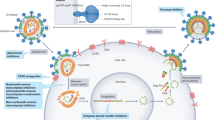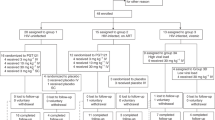Abstract
Highly active antiretroviral therapy (HAART)1,2,3 has dramatically decreased mortality from HIV-1 infection4 and is a major achievement of modern medicine. However, there is no fundamental theory of HAART. Elegant models describe the dynamics of viral replication3,5,6,7,8,9, but a metric for the antiviral activity of drug combinations relative to a target value needed for control of replication is lacking. Treatment guidelines10,11 are based on empirical results of clinical trials in which other factors such as regimen tolerability also affect outcome. Why only certain drug combinations control viral replication remains unclear. Here we quantify the intrinsic antiviral activity of antiretroviral drug combinations. We show that most single antiretroviral drugs show previously unappreciated complex nonlinear pharmacodynamics that determine their inhibitory potential at clinical concentrations. We demonstrate that neither of the major theories for drug combinations accurately predicts the combined effects of multiple antiretrovirals. However, the combined effects can be understood with a new approach that considers the degree of independence of drug effects. This analysis allows a direct comparison of the inhibitory potential of different drug combinations under clinical concentrations, reconciles the results of clinical trials, defines a target level of inhibition associated with treatment success and provides a rational basis for treatment simplification and optimization.
This is a preview of subscription content, access via your institution
Access options
Subscribe to this journal
Receive 12 print issues and online access
$209.00 per year
only $17.42 per issue
Buy this article
- Purchase on Springer Link
- Instant access to full article PDF
Prices may be subject to local taxes which are calculated during checkout




Similar content being viewed by others
References
Gulick, R.M. et al. Treatment with indinavir, zidovudine, and lamivudine in adults with human immunodeficiency virus infection and prior antiretroviral therapy. N. Engl. J. Med. 337, 734–739 (1997).
Hammer, S.M. et al. A controlled trial of two nucleoside analogues plus indinavir in persons with human immunodeficiency virus infection and CD4 cell counts of 200 per cubic millimeter or less. AIDS Clinical Trials Group 320 Study Team. N. Engl. J. Med. 337, 725–733 (1997).
Perelson, A.S. et al. Decay characteristics of HIV-1-infected compartments during combination therapy. Nature 387, 188–191 (1997).
Walensky, R.P. et al. The survival benefits of AIDS treatment in the United States. J. Infect. Dis. 194, 11–19 (2006).
Wei, X. et al. Viral dynamics in human immunodeficiency virus type 1 infection. Nature 373, 117–122 (1995).
Ho, D.D. et al. Rapid turnover of plasma virions and CD4 lymphocytes in HIV-1 infection. Nature 373, 123–126 (1995).
Coffin, J.M. HIV population dynamics in vivo: implications for genetic variation, pathogenesis, and therapy. Science 267, 483–489 (1995).
Perelson, A.S., Neumann, A.U., Markowitz, M., Leonard, J.M. & Ho, D.D. HIV-1 dynamics in vivo: virion clearance rate, infected cell life-span and viral generation time. Science 271, 1582–1586 (1996).
Wodarz, D. & Nowak, M.A. Mathematical models of HIV pathogenesis and treatment. Bioessays 24, 1178–1187 (2002).
Thompson, M.A. et al. Antiretroviral treatment of adult HIV infection: 2010 recommendations of the International AIDS Society-USA panel. J. Am. Med. Assoc. 304, 321–333 (2010).
Department of Health and Human Services Panel on Antiretroviral Guidelines for Adults and Adolescents. Guidelines for the use of antiretroviral agents in HIV-1–infected adults and adolescents. 〈http://www.aidsinfo.nih.gov/ContentFiles/AdultandAdolescentGL.pdf〉 (2009).
Shen, L. et al. Dose-response curve slope sets class-specific limits on inhibitory potential of anti-HIV drugs. Nat. Med. 14, 762–766 (2008).
Hill, A.V. The possible effects of the aggregation of the molecules of huemoglobin on its dissociation curves. J. Physiol. (Lond.) 40, 4–7 (1910).
Chou, T.C. Derivation and properties of Michaelis-Menten type and Hill type equations for reference ligands. J. Theor. Biol. 59, 253–276 (1976).
Holford, N.H. & Sheiner, L.B. Understanding the dose-effect relationship: clinical application of pharmacokinetic-pharmacodynamic models. Clin. Pharmacokinet. 6, 429–453 (1981).
Greco, W.R., Bravo, G. & Parsons, J.C. The search for synergy: a critical review from a response surface perspective. Pharmacol. Rev. 47, 331–385 (1995).
Chou, T.C. Theoretical basis, experimental design, and computerized simulation of synergism and antagonism in drug combination studies. Pharmacol. Rev. 58, 621–681 (2006).
Sampah, M.E., Shen, L., Jilek, B.L. & Siliciano, R.F. Dose-response curve slope is a missing dimension in the analysis of HIV-1 drug resistance. Proc. Natl. Acad. Sci. USA 108, 7613–7618 (2011).
Ferguson, N.M., Fraser, C. & Anderson, R.M. Viral dynamics and anti-viral pharmacodynamics: rethinking in vitro measures of drug potency. Trends Pharmacol. Sci. 22, 97–100 (2001).
Chou, T.C. & Talalay, P. Quantitative analysis of dose-effect relationships: the combined effects of multiple drugs or enzyme inhibitors. Adv. Enzyme Regul. 22, 27–55 (1984).
Shen, L. et al. A critical subset model provides a conceptual basis for the high antiviral activity of major HIV drugs. Sci. Transl. Med. 3, 91ra63 (2011).
Walmsley, S. et al. Lopinavir-ritonavir versus nelfinavir for the initial treatment of HIV infection. N. Engl. J. Med. 346, 2039–2046 (2002).
Siliciano, J.D. & Siliciano, R.F. Biomarkers of HIV replication. Curr. Opin. HIV. AIDS 5, 491–497 (2010).
Katlama, C. et al. Efficacy of darunavir/ritonavir maintenance monotherapy in patients with HIV-1 viral suppression: a randomized open-label, noninferiority trial, MONOI-ANRS 136. AIDS 24, 2365–2374 (2010).
Peréz-Valero, I. & Arribas, J.R. Protease inhibitor monotherapy. Curr. Opin. Infect. Dis. 24, 7–11 (2011).
Bierman, W.F., van Agtmael, M.A., Nijhuis, M., Danner, S.A. & Boucher, C.A. HIV monotherapy with ritonavir-boosted protease inhibitors: a systematic review. AIDS 23, 279–291 (2009).
Markowitz, M. et al. Rapid and durable antiretroviral effect of the HIV-1 Integrase inhibitor raltegravir as part of combination therapy in treatment-naive patients with HIV-1 infection: results of a 48-week controlled study. J. Acquir. Immune Defic. Syndr. 46, 125–133 (2007).
Cooper, D.A. et al. Maraviroc versus efavirenz, both in combination with zidovudine-lamivudine, for the treatment of antiretroviral-naive subjects with CCR5-tropic HIV-1 infection. J. Infect. Dis. 201, 803–813 (2010).
Bliss, C.I. The toxicity of poisons jointly applied. Ann. Appl. Biol. 26, 585–615 (1939).
Loewe, S. & Muischnek, H. Effect of combinations: mathematical basis of problem. Arch. Exp. Pathol. Pharmakol. 114, 313–326 (1926).
Kohlstaedt, L.A., Wang, J., Friedman, J.M., Rice, P.A. & Steitz, T.A. Crystal structure at 3.5 A resolution of HIV-1 reverse transcriptase complexed with an inhibitor. Science 256, 1783–1790 (1992).
Hoggard, P.G., Kewn, S., Barry, M.G., Khoo, S.H. & Back, D.J. Effects of drugs on 2′,3′-dideoxy-2′,3′-didehydrothymidine phosphorylation in vitro. Antimicrob. Agents Chemother. 41, 1231–1236 (1997).
Havlir, D.V. et al. In vivo antagonism with zidovudine plus stavudine combination therapy. J. Infect. Dis. 182, 321–325 (2000).
Wyma, D.J. et al. Coupling of human immunodeficiency virus type 1 fusion to virion maturation: a novel role of the gp41 cytoplasmic tail. J. Virol. 78, 3429–3435 (2004).
Murakami, T., Ablan, S., Freed, E.O. & Tanaka, Y. Regulation of human immunodeficiency virus type 1 Env-mediated membrane fusion by viral protease activity. J. Virol. 78, 1026–1031 (2004).
Müller, B. et al. HIV-1 Gag processing intermediates trans-dominantly interfere with HIV-1 infectivity. J. Biol. Chem. 284, 29692–29703 (2009).
Lennox, J.L. et al. Safety and efficacy of raltegravir-based versus efavirenz-based combination therapy in treatment-naive patients with HIV-1 infection: a multicentre, double-blind randomised controlled trial. Lancet 374, 796–806 (2009).
Gallant, J.E. et al. Early virologic nonresponse to tenofovir, abacavir, and lamivudine in HIV-infected antiretroviral-naive subjects. J. Infect. Dis. 192, 1921–1930 (2005).
Finzi, D. et al. Identification of a reservoir for HIV-1 in patients on highly active antiretroviral therapy. Science 278, 1295–1300 (1997).
Finzi, D. et al. Latent infection of CD4+ T cells provides a mechanism for lifelong persistence of HIV-1, even in patients on effective combination therapy. Nat. Med. 5, 512–517 (1999).
Acknowledgements
We thank J. Blankson, A. Spivak, C. Durand, J. Gallant, J. Cofrancesco and W. Greco for helpful discussions. This work was supported by US National Institutes of Health grant AI081600 and by the Howard Hughes Medical Institute.
Author information
Authors and Affiliations
Contributions
B.L.J., M.Z., M.E.S., C.K.B. and J.L. conducted the experiments. B.L.J., M.Z., S.A.R., L.S. and R.F.S. carried out the computational analysis. R.F.S. supervised the project and wrote the manuscript.
Corresponding author
Ethics declarations
Competing interests
The authors declare no competing financial interests.
Supplementary information
Supplementary Text and Figures
Supplementary Figures 1–7, Supplementary Tables 1–8, Supplementary Methods and Supplementary Notes 1–3 (PDF 5880 kb)
Rights and permissions
About this article
Cite this article
Jilek, B., Zarr, M., Sampah, M. et al. A quantitative basis for antiretroviral therapy for HIV-1 infection. Nat Med 18, 446–451 (2012). https://doi.org/10.1038/nm.2649
Received:
Accepted:
Published:
Issue Date:
DOI: https://doi.org/10.1038/nm.2649
This article is cited by
-
Modeling how antibody responses may determine the efficacy of COVID-19 vaccines
Nature Computational Science (2022)
-
Required concentration index quantifies effective drug combinations against hepatitis C virus infection
Theoretical Biology and Medical Modelling (2021)
-
Safety, pharmacokinetics and antiviral activity of PGT121, a broadly neutralizing monoclonal antibody against HIV-1: a randomized, placebo-controlled, phase 1 clinical trial
Nature Medicine (2021)
-
Highly synergistic drug combination prevents vaginal HIV infection in humanized mice
Scientific Reports (2020)
-
Epigenetic regulation of HIV-1 latency: focus on polycomb group (PcG) proteins
Clinical Epigenetics (2018)



